BHUTAN FESTIVAL 2025
Bhutan, the Land of the Thunder Dragon, is renowned for its colorful and spiritually significant festivals (Tshechus and Drubchens), held throughout the year in various dzongs (fortresses) and monasteries. These festivals celebrate Guru Rinpoche (Padmasambhava), Bhutan’s patron saint who introduced Tantric Buddhism to the region. The masked dances (Cham) performed during Tshechus are believed to purify negative karma, invoke blessings, and impart Buddhist teachings through symbolic movements. In 2025, Bhutan will host numerous festivals, offering visitors a deep cultural and spiritual experience.
Festivals in the Land of the Thunder Dragon: A Spiritual and Cultural Extravaganza
In the mystical kingdom of Bhutan, festivals are not just celebrations—they are vibrant expressions of deep-rooted Buddhist traditions. These grand occasions, known as Tsechus, honor Guru Rinpoche, the revered saint who introduced Buddhism to Bhutan in the 8th century. Held across all districts, these sacred gatherings align with auspicious dates on the Bhutanese lunar calendar and span multiple days, featuring mesmerizing masked dances that narrate ancient legends and spiritual teachings.
More than just religious observances, Tsechus are social and family gatherings that bring communities together in a colorful display of Bhutanese culture. Dressed in their finest handwoven Ghos and Kiras, adorned with heirloom coral and turquoise jewelry, locals arrive at the festival grounds carrying traditional bamboo baskets filled with home-cooked delicacies. They spend the day immersed in sacred performances, laughter, and prayer within the awe-inspiring walls of Bhutan’s dzongs (fortresses) and centuries-old monasteries.
But behind the scenes, an equally profound journey unfolds. Weeks before the festival, monks retreat into deep meditation and prayer, preparing both spiritually and physically to embody the enlightened beings they portray in their sacred dances. Each movement, each step is believed to dispel negativity and bestow blessings upon all who witness them. For the Bhutanese, attending these mystical performances is more than a visual spectacle—it is a pathway to spiritual awakening and enlightenment.
TOP 10 FESTIVAL OF BHUTAN
1.Paro Tshechu – (April 8–12)
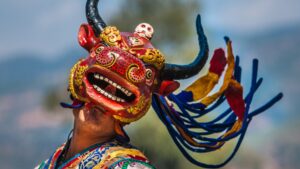
Punakha Tshechu is a mesmerizing celebration held annually within the grand walls of Punakha Dzong, Bhutan’s historic fortress-monastery. Dedicated to Guru Rinpoche, also known as Padmasambhava, this festival pays homage to the saint who brought Tantric Buddhism to the Himalayas. The event is a spiritual and cultural spectacle, where monks, draped in exquisite brocade robes, perform sacred Cham dances—ritualistic movements believed to purify negativity and summon divine blessings. The air resonates with the rhythmic chants of Buddhist scriptures, creating an atmosphere of deep devotion. As the festival reaches its pinnacle, a colossal thangka (sacred scroll painting) is unveiled, depicting Guru Rinpoche surrounded by celestial beings from the Buddhist pantheon. This awe-inspiring moment is said to cleanse sins and bestow merit upon all who witness it. Drawing throngs of pilgrims and visitors alike, Punakha Tshechu is a gateway into Bhutan’s living Buddhist traditions, where faith, folklore, and festivity intertwine.
2.Thimphu Tshechu – (October 2–4)
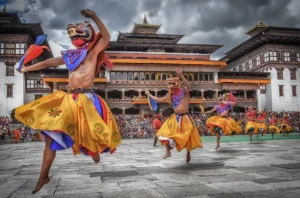
Thimphu Tshechu: A Grand Celebration of Bhutanese Spirituality and Culture
Thimphu Tshechu is one of Bhutan’s most revered religious and cultural festivals, drawing thousands of devotees and travelers to the capital every year. Rooted in centuries-old traditions, this three-day festival is held at Tashichho Dzong, Bhutan’s magnificent fortress-monastery, from October 2nd to 4th in 2025. The festival was introduced in 1670 by the 4th Temporal Ruler, Tenzing Rabgye, to honor Guru Rinpoche, the saint who introduced Tantric Buddhism to Bhutan.
A spectacle of devotion and artistic expression, the festival features Cham dances, performed by monks and lay dancers adorned in elaborate costumes and mystical masks. Each movement narrates ancient Buddhist stories, believed to purify negativity and invoke divine blessings. The air resonates with traditional music and prayer chants, while locals dressed in their most exquisite attire add vibrant colors to the scene. Beyond its religious significance, Thimphu Tshechu is a grand social affair, offering visitors an unforgettable glimpse into Bhutan’s rich heritage. With limited accommodations, early booking is recommended to witness this mesmerizing event.
3.Punakha Drubchen – (March 6–8)
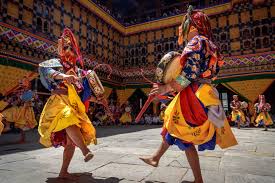
Punakha Drubchen: A Celebration of Bhutanese Valor and Spirituality
Held annually in the magnificent Punakha Dzong, Punakha Drubchen is a festival deeply rooted in Bhutanese history and patriotism. Scheduled from March 6 to 8, 2025, this grand event commemorates Bhutan’s 17th-century triumph over Tibetan forces, a defining moment in the nation’s past. Unlike other Tshechus, Punakha Drubchen uniquely features a reenactment of this historic battle, with local men dressed as warriors, reviving the bravery that once safeguarded Bhutan’s sovereignty.
The festival is a captivating fusion of devotion and drama, where sacred Cham dances performed by monks invoke deities and spiritual blessings, while the battle reenactments honor the indomitable Bhutanese spirit. Set against the backdrop of Punakha Dzong, also known as “the palace of great happiness or bliss,” the festival offers a surreal experience of Bhutan’s cultural legacy.
4.Jambay Lhakhang Drup -(November 5 to 8)
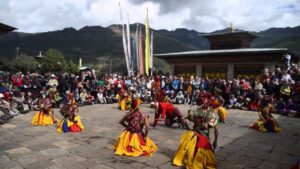
Held at the ancient Jambay Lhakhang in the mystical Bumthang Valley, Jambay Lhakhang Drup is one of Bhutan’s oldest and most sacred festivals, taking place from November 5 to 8, 2025. This revered event, deeply rooted in Bhutanese history and spirituality, is a tribute to Guru Rinpoche, who played a pivotal role in introducing Buddhism to Bhutan.
A highlight of the festival is the “Ter Cham” (Fire Ritual)—a rare and electrifying midnight performance where masked dancers, some performing the famous naked dance, move through blazing flames. This ritual is believed to cleanse negativity, bless those in attendance, and ensure prosperity for the coming year. Alongside this sacred ceremony, the festival features a series of elaborate mask dances (Cham), prayers, and cultural performances, drawing pilgrims, monks, and visitors into its mesmerizing atmosphere.
For those seeking a profound connection with Bhutanese faith, folklore, and festivity, Jambay Lhakhang Drup is an unmissable experience, offering a rare glimpse into the mystical traditions that define Bhutan’s spiritual soul.
5.Black-Necked Crane Festival- (November 11)
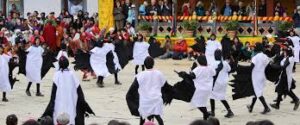
Every year on November 11, the serene Phobjikha Valley comes alive with the Black-Necked Crane Festival, a heartwarming tribute to the endangered black-necked cranes that migrate from the Tibetan Plateau to Bhutan for the winter. Held at the historic Gangteng Monastery, this one-of-a-kind festival is a beautiful blend of spiritual reverence, cultural expression, and environmental conservation.
As the crisp mountain air carries the echoes of traditional Bhutanese songs and masked dances, local schoolchildren take center stage, performing choreographed routines dressed as cranes—a symbolic representation of the sacred bond between Bhutanese people and nature. The festival is not just a spectacle but an educational experience, raising awareness about the importance of protecting these majestic birds and their fragile wetland habitat. Conservationists, monks, villagers, and tourists come together to celebrate, emphasizing Bhutan’s unique commitment to living in harmony with all beings.
Beyond the performances, visitors can explore Phobjikha Valley’s breathtaking landscapes, home to some of the world’s last black-necked crane roosting grounds. The festival offers a rare opportunity to witness Bhutan’s environmental ethos in action, making it an unforgettable experience for nature lovers, bird watchers, and cultural enthusiasts alike.
6. Druk Wangyel Tshechu – (December 13)

Set against the breathtaking backdrop of the Himalayas, the Druk Wangyel Tshechu is a festival unlike any other in Bhutan. Held annually on December 13 at the Dochula Pass, this festival is a modern addition to Bhutan’s rich cultural tapestry, yet deeply rooted in the country’s history, spirituality, and national pride. Unlike other Tshechus, which primarily celebrate religious figures, Druk Wangyel Tshechu honors Bhutan’s Fourth King, His Majesty Jigme Singye Wangchuck, and the Bhutanese armed forces for their victorious military campaign in 2003 against insurgents who threatened Bhutan’s sovereignty.
The festival takes place at the Druk Wangyel Lhakhang, a monastery built by Her Majesty Queen Mother Ashi Dorji Wangmo Wangchuck, overlooking 108 chortens (stupas) that symbolize peace and unity. The performances here are exclusive to this festival, featuring warrior-inspired Cham dances, vibrant costumes, and intricately choreographed movements that blend history with spirituality. The crisp mountain air, the panoramic views of snow-capped peaks, and the echoes of traditional music create an awe-inspiring atmosphere that captivates all who attend.
Beyond the mesmerizing dances, Druk Wangyel Tshechu is a symbol of Bhutan’s resilience and harmony, reminding visitors of the country’s unique approach to blending modernity with deep-rooted traditions. It is an event that celebrates not just history, but the unwavering spirit of the Bhutanese people. For travelers, attending this festival is a rare opportunity to experience Bhutan’s living history, cultural grandeur, and spiritual essence all in one unforgettable day.
7.Jomolhari mountain festival – (October 14-15)
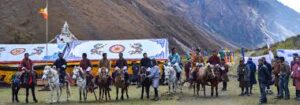
Held at the breathtaking base of Mount Jomolhari, the Jomolhari Mountain Festival is a unique two-day celebration of Bhutan’s highland communities and environmental conservation. Scheduled for October 14–15, 2025, this extraordinary festival brings together the Soe Yaksa and Soe Yutoed communities, who reside along the scenic Jomolhari trekking route. Against the stunning backdrop of Bhutan’s third-highest peak (7,326m), the festival offers a rare glimpse into the traditions, resilience, and lifestyle of the nomadic yak herders who call these mountains home.
More than just a cultural gathering, the festival plays a crucial role in snow leopard conservation, raising awareness about this elusive and endangered predator that roams Bhutan’s high-altitude landscapes. Through storytelling, music, and vibrant mask dances, locals express their deep spiritual connection to nature, reinforcing the harmony between humans and wildlife. Traditional archery matches, horseback riding competitions, and indigenous games further enrich the festivities, while visitors can savor authentic highland delicacies and witness artisans crafting intricate yak wool textiles.
Beyond the festivities, the Jomolhari Mountain Festival is an initiative supporting sustainable eco-tourism and local livelihoods. By attending, visitors not only experience the untouched beauty of the Himalayas but also contribute to Bhutan’s pioneering conservation efforts. The festival embodies the essence of Bhutan’s Gross National Happiness philosophy, where cultural preservation, environmental protection, and community well-being go hand in hand.
8. Kurjey Tshechu -(July 5)

Kurjey Tshechu, held annually in Bumthang’s sacred Kurjey Lhakhang, is a profound spiritual and cultural celebration honoring Guru Rinpoche, the saint who introduced Buddhism to Bhutan. Taking place in June or July, the festival is centered around the monastery where Guru Rinpoche’s body imprint is believed to be embedded in rock. The highlight of the Tshechu is the Cham dances, where monks perform masked rituals symbolizing the victory of wisdom over ignorance. Another sacred moment is the unfurling of the Thongdrol, a giant tapestry of Guru Rinpoche, which is believed to liberate onlookers from past sins upon sight. Locals arrive in vibrant attire, carrying bamboo baskets of traditional food, making it a joyous social gathering as well. This festival offers a rare insight into Bhutan’s Buddhist heritage, communal spirit, and artistic traditions, making it an unmissable experience for spiritual seekers and cultural explorers alike.
9. Trashigang Tshechu-(November 29–December 1)
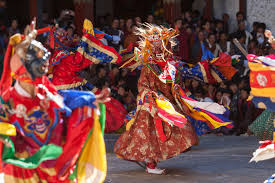
Held at the historic Trashigang Dzong, perched dramatically above the confluence of the Drangme Chhu and Gamri Chhu rivers, the Trashigang Tshechu is eastern Bhutan’s grandest festival. Scheduled for November 29–December 1, 2025, this three-day event is a powerful blend of religious devotion, cultural heritage, and community gathering. Established in 1659, the majestic Trashigang Dzong has long served as a spiritual and administrative stronghold, making it an awe-inspiring setting for this sacred festival.
A highlight of the Tshechu is the performance of Cham dances, where monks, adorned in vibrant brocade costumes and fearsome masks, bring to life ancient Buddhist legends. These mystical dances are believed to purify negativity, invoke divine blessings, and ward off evil spirits, creating a deeply spiritual atmosphere. Devotees and visitors alike gather to witness this sacred spectacle, as rhythmic drumbeats and haunting chants echo through the valley.
What makes Trashigang Tshechu truly unique is the participation of the Brokpas—semi-nomadic highlanders from the Merak and Sakteng regions. Dressed in their distinctive handwoven red and white woolen attire, adorned with yak-hair hats, they descend from the remote mountains to take part in the festivities. Their presence adds a rare cultural dimension to the Tshechu, offering visitors a glimpse into Bhutan’s diverse ethnic traditions.
Another unforgettable moment is the unveiling of the Thongdrol, a massive sacred scroll painting of Guru Rinpoche, which is believed to grant spiritual liberation upon sight. Locals arrive in their finest Ghos and Kiras, carrying traditional bamboo baskets filled with home-cooked delicacies, transforming the festival into a joyous social gathering where faith, folklore, and festivity intertwine.
For travelers, attending the Trashigang Tshechu is a rare opportunity to experience Bhutan’s spiritual heartland, witness its vibrant highland culture, and be part of a centuries-old tradition that continues to thrive. With its remote yet stunning location, it is a pilgrimage of both the soul and the senses, making it one of the most unforgettable festivals in the Kingdom of Bhutan.
10. Trongsa Tshechu (December 27 to 31, 2025)
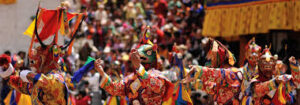
Held in the magnificent Trongsa Dzong, the largest and one of the most historically significant fortresses in Bhutan, the Trongsa Tshechu is a grand five-day festival celebrated from December 27 to 31, 2025. As the spiritual and administrative heart of central Bhutan, Trongsa has long been a place of political power and religious devotion, making this festival an extraordinary blend of history, culture, and faith.
At the heart of the Trongsa Tshechu are the Cham dances, a series of mesmerizing masked performances by monks and lay dancers, each portraying stories of Buddhist deities, protector spirits, and moral lessons. These dances, performed in vibrant silk robes and elaborate masks, are believed to purify sins, ward off evil, and bless all who witness them. Among the most anticipated moments of the festival is the unveiling of the Thongdrel, a massive silk applique thangka (sacred scroll) depicting Guru Rinpoche and other revered figures. The mere sight of this Thongdrel at sunrise is believed to bring spiritual liberation and immense merit to all attendees.
Beyond its religious significance, the Trongsa Tshechu serves as a major social gathering, drawing villagers from remote mountain hamlets and across Bhutan. People arrive dressed in their finest handwoven Ghos and Kiras, adorned with heirloom jewelry, carrying beautifully packed picnic baskets filled with local delicacies. The dzong’s vast courtyards become a place of laughter, storytelling, and shared cultural pride, where generations come together to strengthen their bonds and celebrate their Bhutanese identity.
Set against the awe-inspiring backdrop of the Black Mountains, overlooking the deep Mangde Chhu river valley, the Trongsa Tshechu is more than just a festival—it is a journey into Bhutan’s soul, where faith, folklore, and festivity intertwine in a truly magical experience. For travelers seeking to immerse themselves in authentic Bhutanese spirituality and culture, this festival offers an unforgettable glimpse into a timeless tradition.
HOW TO BOOK TOUR ?
Attending a Bhutanese festival (Tshechu or Drubchen) is a once-in-a-lifetime experience, but since these festivals attract large crowds of both locals and tourists, it is essential to plan and book in advance. Here’s a step-by-step guide on how to secure your trip for a Bhutan Festival Tour in 2025.
Choose Your Festival & Dates
Bhutan hosts multiple festivals throughout the year across different regions. Select the festival based on your interest, location, and travel dates. Popular festivals in 2025 include:
✅ Paro Tshechu (April 8–12, 2025) – One of the most famous and accessible.
✅ Thimphu Tshechu (October 2–4, 2025) – The largest in Bhutan’s capital.
✅ Jambay Lhakhang Drup (November 5–8, 2025) – Known for its fire ritual and naked dance.
✅ Black-Necked Crane Festival (November 11, 2025) – A unique wildlife and cultural event.
2️⃣ Contact a Licensed Bhutanese Tour Operator
Independent travel to Bhutan is not allowed, so all visitors must book through an authorized Bhutanese tour operator or international travel agency that partners with one. Some well-known operators include:
BHUTAN LUXURY TOUR (https://bhutanluxurytour.com/)
3️⃣ Get Your Bhutan Visa & Daily Tariff
🔹 All tourists need a visa to enter Bhutan, which your tour operator will process.
🔹 Bhutan follows a Sustainable Development Fee (SDF) model, with visitors paying $200 per person per night (as of 2024).
🔹 Your tour package includes visa fees, accommodation, meals, a licensed guide, festival access, and transport.
4️⃣ Book Flights to Bhutan (Drukair / Bhutan Airlines)
Flights to Bhutan are limited and operated only by Drukair and Bhutan Airlines, flying from cities like Bangkok, Delhi, Singapore, and Kathmandu. Secure your Paro International Airport (PBH) flight early, as tickets sell out quickly during festival season.
5️⃣ Confirm Accommodation & Travel Arrangements
Since festivals attract large crowds, hotels and lodges in cities like Paro, Thimphu, and Bumthang get booked months in advance. Your tour operator will arrange your stay, but if you prefer luxury stays (Six Senses, COMO Uma, or Amankora), book well in advance.
6️⃣ Pack Smart & Prepare for the Experience
✔ Dress modestly (Bhutanese wear their finest attire to festivals).
✔ Carry a good camera (photography is allowed, but drones may need permits).
✔ Prepare for altitude changes (many festival sites are in high-altitude areas).
7️⃣ Enjoy the Festival & Explore Bhutan!
Beyond the festival, extend your trip to explore Bhutan’s stunning landscapes and cultural landmarks like Tiger’s Nest Monastery, Dochula Pass, and Punakha Dzong.

